Did you know participation in dog agility events has risen over 200% in the past decade? This explosive trend isn't just about flashy competitions—it's about unlocking the full athletic and mental potential of our dogs. Dog agility training is more than a sport; it’s a powerful method for boosting your pet’s fitness, happiness, and bond with you. Whether you have a high-energy breed or a couch-loving pup, understanding the secrets behind successful agility training will inspire you to get moving and have fun together. Read on to uncover how agility can transform your dog's life—and yours.
The Surging Popularity of Dog Agility Training: Surprising Facts That Will Inspire You
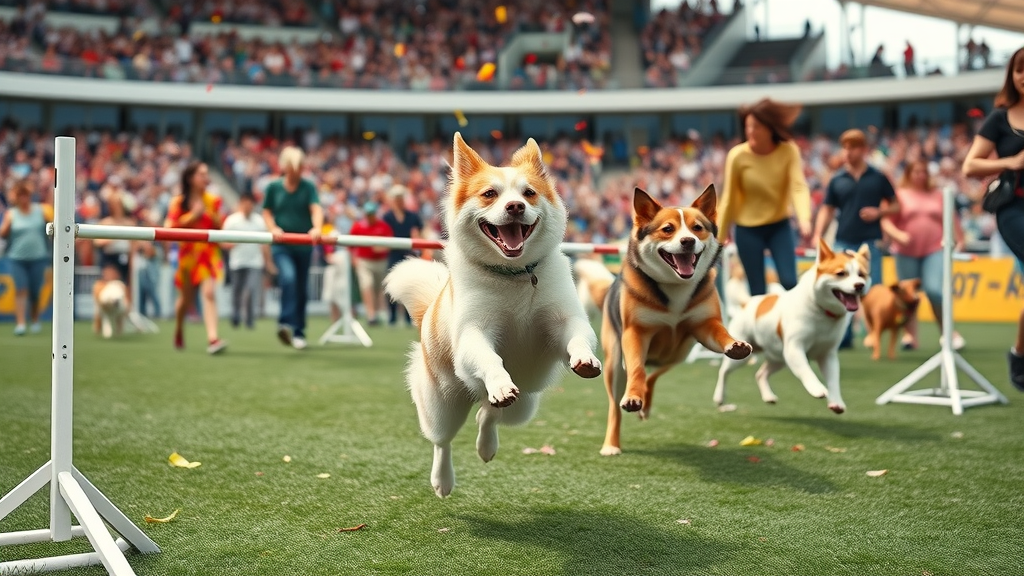
- Did you know that participation in dog agility events has increased by over 200% in the last decade? This explosive growth highlights the value of dog agility training not only as a competition but as a fundamental tool for canine health, mental stimulation, and bonding with your furry friend.
The world of dog agility is booming, and it’s easy to see why. With more dog sports making their way onto national television, agility competitions have become mainstream entertainment. But beyond the spectacle, dog agility training has proven benefits. Recent studies show dogs enrolled in agility classes display higher overall fitness, improved behavior, and greater mental stimulation—key advantages for dogs of any age or breed. Plus, agility training doesn’t require elite-level athletes; dogs of all sizes, backgrounds, and skill levels are encouraged to participate.
Owners are discovering that agility offers a double reward: you can strengthen the canine-human bond while channeling your dog's energy constructively. From foundational commands to advanced agility skills, the agility course test presents exciting challenges that keep your dog engaged and motivated. This surge also reflects a growing movement toward positive, force-free dog training philosophies—so if you’re on the fence about starting, there’s never been a better time to join the agility revolution!
Unlocking Peak Fitness: Why Dog Agility Training Matters for Every Dog
- Improves your dog's overall fitness, balance, and coordination.
- Boosts your dog's confidence and problem-solving skills.
- Deepens your relationship through positive reinforcement.
- Addresses behavioral concerns by channeling energy constructively.
Dog agility training is so much more than a fun activity—it's an all-encompassing program for both physical and mental development. As a canine sport, agility works every major muscle group, improving your dog’s balance, coordination, and cardiovascular health. Courses require dogs to run, jump, weave, and react to handler cues, making agility one of the best tools for building peak fitness and body awareness.
At the same time, agility fosters confidence and cognitive skills. Each obstacle conquered builds your dog’s problem-solving abilities and resilience. Regular training sessions are an excellent outlet for excess energy, redirecting behaviors like chewing or barking into constructive exercise. By using positive reinforcement, handlers create a feedback loop of trust and joy—creating a bond that’s difficult to match elsewhere. No matter your dog’s age or level agility, agility training offers benefits that last a lifetime.
What You'll Master in Dog Agility Training (And Why It Matters)
- Essential agility training concepts and benefits
- How to set up and use agility equipment at home
- Step-by-step plans to teach your dog specific agility skills—like weave poles and jumps
- Tips for joining your first agility class or competition
- Common mistakes and troubleshooting strategies
Embarking on the dog agility training journey equips you with knowledge that extends far beyond the backyard. You’ll learn about core agility concepts like body awareness, impulse control, and gradual skill progression. You’ll discover how to assemble agility equipment from everyday materials—think PVC pipe for weave poles or old hula hoops for a tire jump—so you can practice agility skills at home on a budget.
Mastering specific techniques for challenges, such as weaving through poles or leaping over jumps, keeps your dog’s brain and muscles active. You’ll also explore step-by-step strategies for joining an agility class , understanding competition standards, and avoiding beginner mistakes. With these tools, you can confidently teach your dog, customize your approach, and troubleshoot common hurdles along the way.
Dog Agility Training Fundamentals: Core Concepts and Best Practices
Understanding Dog Agility and the Sports of Agility
- Definition and origins of dog agility
- Overview of the sport of agility and competition standards

Dog agility was inspired by show jumping in equestrian sports and made its public debut in the United Kingdom during the late 1970s. Since then, it has evolved into a worldwide phenomenon, becoming one of the most popular dog sports in the United States and beyond. The sport of agility involves a timed obstacle course, where dogs race against the clock guided only by their handler’s voice and body language—testing communication, obedience, and athletic skill.
Modern agility trials test a wide range of skills, from lightning-quick weave poles to the focus required for a pause table or the power to clear a tire jump. Official competitions, like those sanctioned by AKC or USDAA, adhere to strict standards for course design and safety. Yet, even outside the ring, agility’s foundational values make it a mainstay of dog training classes and home-training regimens for a growing canine community.
Body Awareness: The Key Ingredient in Dog Agility Training
- Exercises for balance and coordination
- How body awareness impacts agility performance
Developing body awareness is central to agility success. Before weaving through poles or jumping hurdles, your dog must learn to control his body—finding balance, rhythm, and spatial awareness. Simple exercises like walking your pup over low boards, balancing on wobble cushions, or moving between cones can boost coordination and reduce injury risk. These games aren’t just for elite athletes; every agility dog benefits from foundation work.
A dog equipped with strong body awareness performs agility obstacles more efficiently, makes sharper turns, and avoids missteps that could cause setbacks. As you teach your dog to navigate spaces thoughtfully, you’re also building core strength and confidence. In fact, many successful trainers highly recommend body awareness routines as a daily warm-up or an essential part of any comprehensive agility training regimen.
Dog Agility Equipment Essentials: Must-Have Tools for Training
Building Your Own Agility Course: Jumps, Weave Poles, and More
- DIY and commercial agility equipment explained
- Safety best practices
- Weave poles: design, spacing, and progression
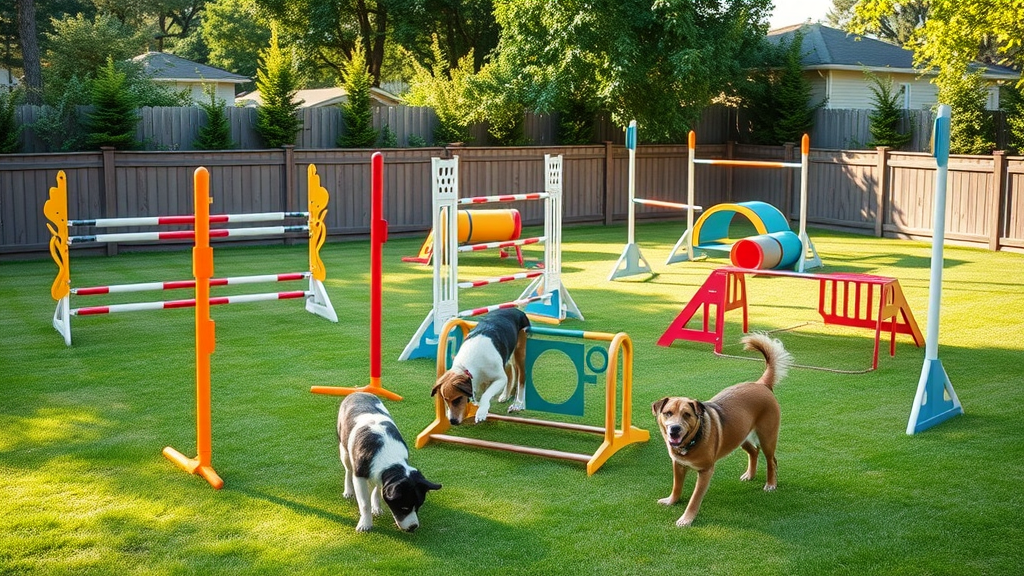
Whether you’re training for fun or getting ready to compete, building a basic agility course at home doesn’t need to break the bank. Many agility obstacles, like jumps and weave poles, can be constructed using tools like PVC pipe or repurposed household objects. Commercial agility equipment is also available for those who prefer professional-grade setups, offering adjustable heights and durable materials for frequent use.
Safety should always come first in dog agility training . Ensure obstacles are stable, free from sharp edges, and appropriately spaced to prevent injury. For weave poles , a common progression is starting with wider spacing and gradually narrowing as your dog’s skills improve. As with a tire jump or pause table, build confidence and precision through positive reinforcement, making agility a rewarding and safe experience for your dog.
| Equipment | Features | Pros | Cons |
|---|---|---|---|
| Weave Poles | Adjustable configuration, can be DIY or commercial, common in competition | Builds coordination, improves focus, easy to store | Requires gradual skill progression |
| Jumps (Bar & Tire) | Heights adjustable, portable, often built with PVC pipe | Versatile, fun, boosts power and leaping skills | Can be unsafe if heights are too ambitious |
| Tunnels | Flexible, collapsible for portability, used for speed/agility | High excitement, engages even timid dogs | Needs careful anchoring to avoid shifting |
| Pause Table | Sturdy platform, teaches stay/impulse control | Improves obedience under distraction | May require acclimation for cautious dogs |
Getting Started: When Should a Dog Start Agility Training?
- Recognizing the right age and physical readiness for agility training
- Veterinarian insights: screening for health and fitness
"The foundation of successful agility training is early, positive exposure, ideally started as young as 6-12 months depending on breed and physical development." – Certified Agility Trainer
Timing is crucial in agility training. Most dogs can begin foundation agility skills as early as 6-12 months of age, but the right age depends on your dog’s breed, size, and unique health considerations. Larger breeds or those with orthopedic risks may benefit from waiting until their joints are fully developed before attempting jumps or strenuous obstacles.
Consulting your veterinarian before starting dog agility training is always advisable. A professional health screening ensures your pup is physically prepared for the activity. Keep sessions short and focus on body awareness, obedience skills, and playful engagement before advancing to more demanding agility obstacles. Remember: positive, gradual exposure lays the groundwork for long-term success and safety in this exciting canine sport.
Agility Training Classes vs. Home Training: Which Is Right for Your Dog?
Benefits of Joining an Agility Class
- Socialization for dogs and handlers
- Professional instruction and feedback
- Access to advanced agility equipment
Participating in an agility class provides structure, feedback, and camaraderie for both dogs and owners. Group classes encourage socialization—helping your dog learn to focus amid distractions, and allowing owners to exchange tips and experiences. A certified agility instructor can spot subtle errors, recommend modifications, and accelerate learning, ensuring safety while developing advanced agility skills.
Another perk of an agility class is exposure to competition-grade agility equipment . Your dog will become comfortable with a wide variety of obstacles—including the famed weave poles , tire jumps, ramps, and more—preparing them for future agility events. From first-timers to seasoned teams, classes are tailored to all skill levels; find a local facility or check out regional dog sports clubs to get started.
Tips for Teaching Your Dog Agility Training at Home
- How to gradually introduce new obstacles
- Building focus and motivation through play
Home training is a flexible and budget-friendly way to teach your dog agility skills. Start by introducing simple obstacles like cardboard boxes to crawl through or broomsticks laid across chairs for beginner jumps. Advance to more sophisticated setups using PVC pipe or commercial kits as your dog's confidence grows. Always introduce new agility obstacles slowly, allowing your dog to investigate and problem-solve at their own pace.
Motivation is the secret to effective dog training . Use treats, toys, and enthusiastic praise to reward even small successes. Short, energetic sessions—peppered with play breaks—keep your dog eager for the next challenge. By cultivating a positive training environment, your home can become a launchpad for a lifetime of joyful agility achievement.
Video Walkthrough: Setting Up a Beginner Dog Agility Course in Your Backyard Watch a step-by-step video guide by a certified trainer, covering how to use household items for jumps, tunnels, and weave poles. Practical, safety-focused tips make it easy for anyone to get started with minimal investment.
Step-by-Step Guide: How Do You Train Your Dog for Agility?
- Obedience basics: Start by reinforcing sit, stay, and come. These foundational commands are vital for safety and communication throughout agility training.
- Introduction to agility obstacles: Begin with low jumps and tunnels, ensuring your dog is comfortable before progressing to more complex challenges.
- Teaching weave poles: Use shaping, luring, or the channel method to introduce your dog to weaving. Gradually increase speed and complexity as your dog masters the pattern.
- Building speed and confidence: Make every session a game! Use rewards, chase games, or play to encourage enthusiasm for agility skills.
- Sequencing obstacles: Put it all together by linking two or more obstacles, gradually building up to a full agility course test.
By following these steps, you not only train your dog for agility but also unlock a world of mental stimulation, fun activities, and practical problem-solving. Whether you intend to compete in a formal agility trial or simply enjoy structured play, the journey is full of rewarding moments for both you and your pup.
Essential Agility Training Commands Every Dog Should Know
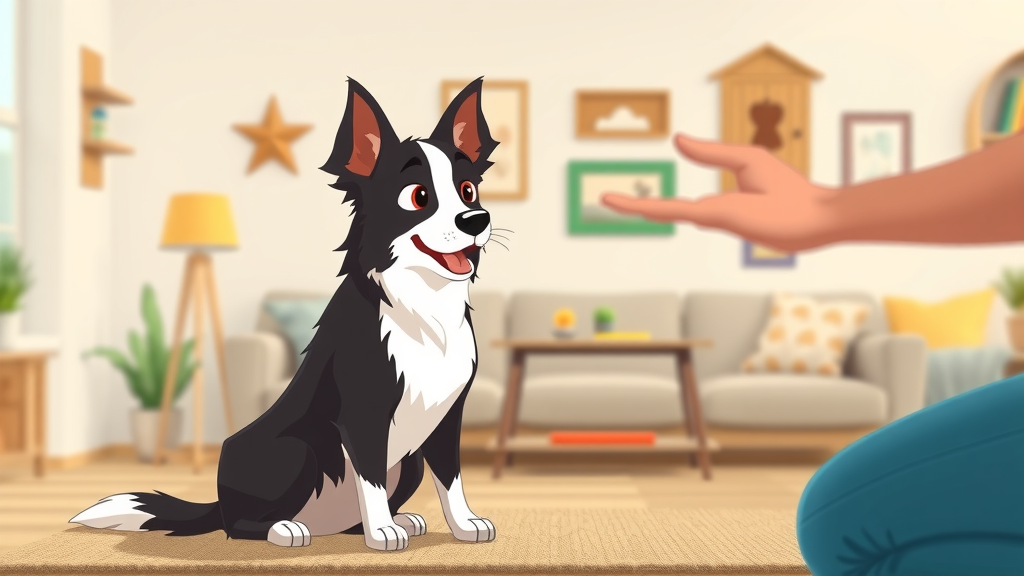
- Sit, stay, come (foundation commands)
- Go, over, through, weave (agility-specific commands)
- Tips for clear communication and consistency
Effective communication is the backbone of agility training . Basic obedience commands —like "sit," "stay," and "come"—are non-negotiable, as they allow for precise control on the course. For agility-specific tasks, cues like "go," "over," "through," and "weave" are introduced. Consistency and tone matter: use the same words and body language for each cue, and always reward correct responses.
Practicing commands at home, in the park, and even during casual walks reinforces their meaning in any environment. Teaching your dog to pause on a table or weave between poles on cue isn’t just helpful for the sport of agility —it’s practical training that sharpens impulse control and focus.
| Command | Meaning | When to Use |
|---|---|---|
| Sit | Dog sits and awaits next cue | Start line, pause table |
| Stay | Dog holds position till released | Obstacle reset, between sequences |
| Come | Dog returns to handler | Recall after obstacles or distractions |
| Go | Move forward or begin course | Start of sequence or new obstacle |
| Over | Jump over bar or hurdle | Approaching a jump |
| Through | Run through tunnel or tire jump | At tunnel, tire, or hoop |
| Weave | Navigate weave poles in sequence | Weave pole sequence |
How Much Does Dog Agility Training Cost?
- Breakdown: cost of agility classes, private lessons, and home equipment
- How to budget for ongoing training and competition fees
"Many dog owners start with simple DIY equipment, spending less than $100 to spark a lifelong passion for agility training." – Agility Enthusiast
The price of dog agility training depends on your approach. Joining a group agility class typically runs from $100–$200 per multi-week course. Private lessons with expert trainers average $50–$100 per session, offering personalized feedback for competition-level agility. If you prefer home training, you can set up basic agility obstacles with household items or DIY supplies like PVC pipe for under $100.
For those with serious competitive ambitions, factor in the cost of advanced gear, travel, and agility event entry fees—which can add up depending on frequency and level. Regardless of your budget, agility offers flexible entry points. Remember: the real investment is the time, consistency, and positivity you dedicate to your dog's development.
Advanced Dog Agility Training: Taking Skills to the Next Level
Competing in Agility Events: Rules, Registration, and Tips
- How to enter your first agility competition in the United States
- Key organizations: AKC, USDAA, UKI
- Prepping your dog for a show environment
If you dream of seeing your agility dog competing on the big stage, the United States offers plenty of opportunities. Start by registering with organizations like AKC (American Kennel Club), USDAA (United States Dog Agility Association), or UKI (UK Agility International). Their websites list events, rules, and registration steps. Many agility events offer beginner divisions, so even newbies can get a taste of the action.
Before your first agility trial , help your dog acclimate to noise, crowds, and new agility equipment. Practice in new environments and use familiar cues to build comfort. Remember that shows are about fun and progress, not perfection. A supportive, stress-free mindset is more important than any ribbon.
Maximizing Performance: Nutrition, Rest, and Injury Prevention
- Ensuring optimal canine sports nutrition
- Warm-up and cool-down exercises for dogs
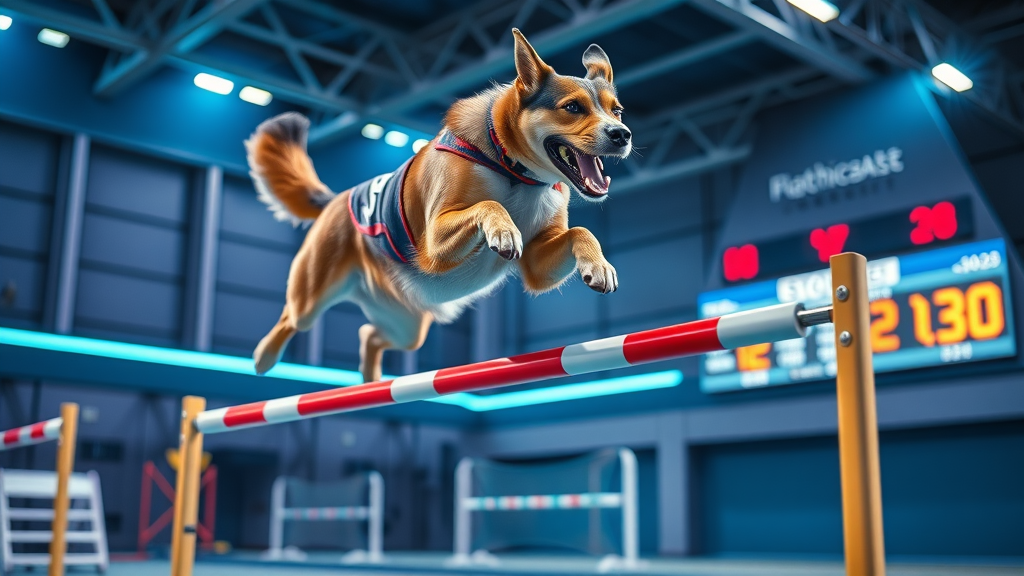
Achieving peak potential in dog agility training requires attention to overall wellness. Nutritional needs for agility athletes differ from pets leading more sedentary lifestyles. Choose high-quality diets, ideally formulated with your veterinarian’s input, to fuel sustained energy and muscle repair.
Injury prevention is essential at every level agility. Begin and end each session with gentle walking and stretching to warm up and cool down joints. Watch for signs of fatigue, and give your dog rest days—overtraining can lead to both physical injuries and mental burnout. Regular checkups ensure your canine sport star stays healthy for the long haul.
Mistakes to Avoid in Dog Agility Training (and How to Troubleshoot Challenges)
- Skipping body awareness training
- Inconsistent cues and training schedules
- Overtraining: warning signs and solutions
- How to keep training safe and positive
Even the most enthusiastic handlers can make mistakes in dog agility training . Common pitfalls include neglecting body awareness —which lays the foundation for all agility skills—and offering inconsistent cues that can confuse your dog. Set a regular training schedule and use the same verbal and physical signals for each command.
Overtraining is another risk; dogs need rest to avoid injury and stay motivated. If your dog seems distracted, reluctant, or physically sore, take a break and return with fresh energy. Keep every session positive by rewarding effort, celebrating progress, and making agility a fun activity rather than a chore. The secret to long-term success? Safety, patience, and joy—every step of the way.
People Also Ask: Expert Answers to Common Dog Agility Training Questions
When should a dog start agility training?
- Most dogs can begin foundation agility training at 6-12 months of age, but consult your veterinarian to account for breed and health considerations. Puppies should avoid full-height jumps or strenuous exercises until their joints are fully developed.
How do you train your dog for agility?
- Start with obedience and body awareness exercises, then introduce basic agility equipment like tunnels and low jumps. Use positive reinforcement and keep sessions short, engaging, and fun.
How much does dog agility training cost?
- Group agility classes typically range from $100-$200 per course, private sessions are $50-$100/hour, and home training can be customized for under $100 in equipment costs.
What are the basic agility commands?
- "Go", "over", "through", "weave"—clear, consistent verbal cues are key. Train these alongside obedience basics like "sit", "stay", and "come."
Frequently Asked Questions About Dog Agility Training
- Is dog agility training safe for all breeds? Most breeds can participate in agility at a level appropriate for their size and age. Always consult your veterinarian before starting, and adjust obstacles and intensity to suit your individual dog.
- What time commitment is needed per week? Short, frequent sessions are best—about 10–20 minutes, 2–4 times per week. Consistency matters more than long sessions.
- Do you need prior experience to start agility classes? No prior experience is necessary. Reputable clubs and trainers welcome all skill levels and will guide you and your dog from the ground up.
- How do I find local agility classes or trainers? Search the AKC or USDAA websites, join local dog sports clubs, or ask for referrals at your veterinarian’s office or pet supply store.
Actionable Tips to Teach Your Dog and Keep Agility Fun
- Rotate training routines for variety
- Reward progress with treats or playtime
- Celebrate small victories—keep it positive
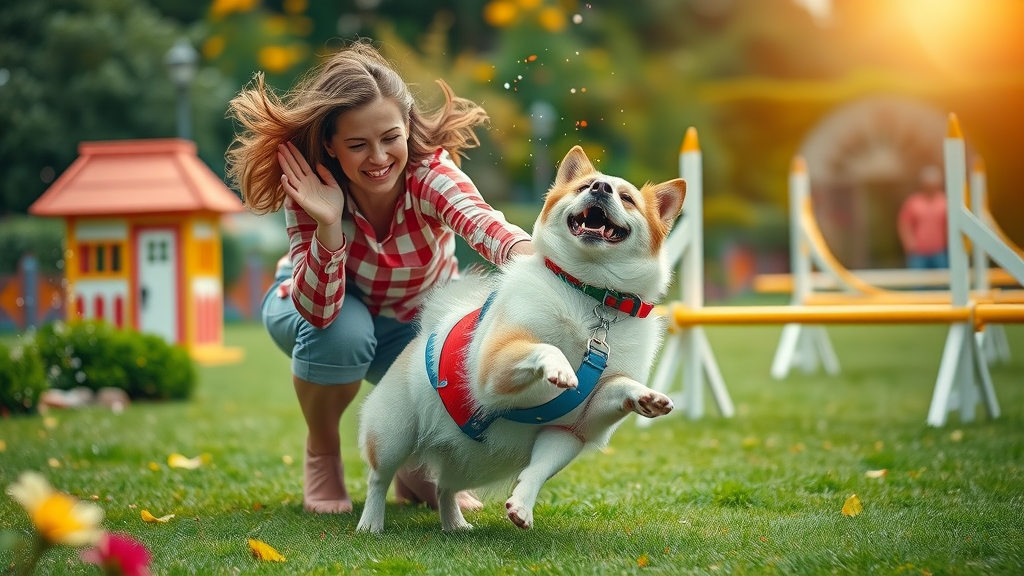
The key to a lasting love for dog agility training is variety and positivity. Spice up routines to keep your pup curious, switch up rewards between treats, toys, and play sessions, and celebrate incremental gains—no victory is too small in this sport of teamwork!
Remember: a happy, motivated agility dog is one who sees training as a chance to bond. When agility feels like joyful play, your dog will consistently give their best performance.
Take the Next Step: Start Your Dog Agility Training Journey Today
- Incorporate agility exercises into daily walks
- Seek out nearby agility classes or online tutorials
- Remember: patience and positivity yield the best long-term results!
"Agility isn't just about speed or winning—it's about building trust, confidence, and lasting joy in your relationship with your dog." – Leading Canine Educator
With so many resources available—from home DIY options to professional agility classes —there’s nothing stopping you from starting today. Take small steps, stay consistent, and keep every experience upbeat and rewarding. The path to peak canine fitness and happiness can start with a single jump!
Keep Your Pup Happy, Fit, and Engaged with Dog Agility Training
- Explore fun, easy agility activities for every dog and every day—boost bonding, burn energy, and beat boredom as you master the secrets of dog agility training together!
Keep your pup happy, healthy, and engaged—discover fun, easy activities for dogs that boost bonding, burn energy, and beat boredom every day!
Ready to unleash your dog's full athletic and mental potential? Start your dog agility training adventure today, and watch the transformation unfold!
To enhance your understanding of dog agility training, consider exploring the following resources:
-
“10 Tips to Practice Agility at Home with Your Dog” : This article from the American Kennel Club provides practical advice on initiating agility training in your own backyard, emphasizing the importance of making training sessions enjoyable and rewarding for your dog. ( akc.org )
-
“Agility: Get Started” : Also from the American Kennel Club, this resource offers a comprehensive overview of agility training, detailing the basics of the sport, necessary equipment, and steps to begin training, making it suitable for both beginners and those looking to deepen their knowledge. ( akc.org )
These resources will provide you with valuable insights and practical tips to effectively engage in agility training with your dog.
 Add Row
Add Row  Add
Add 


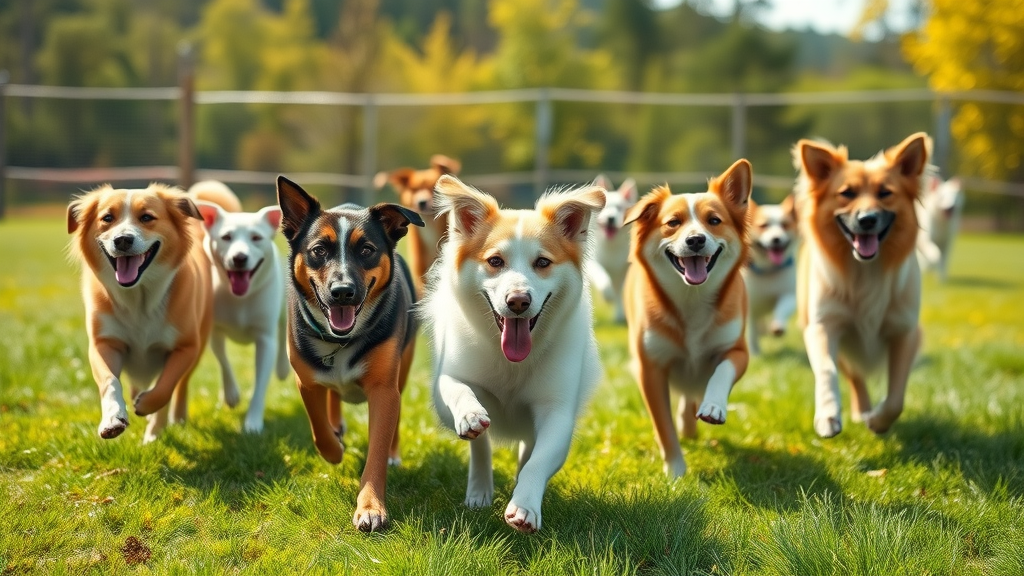
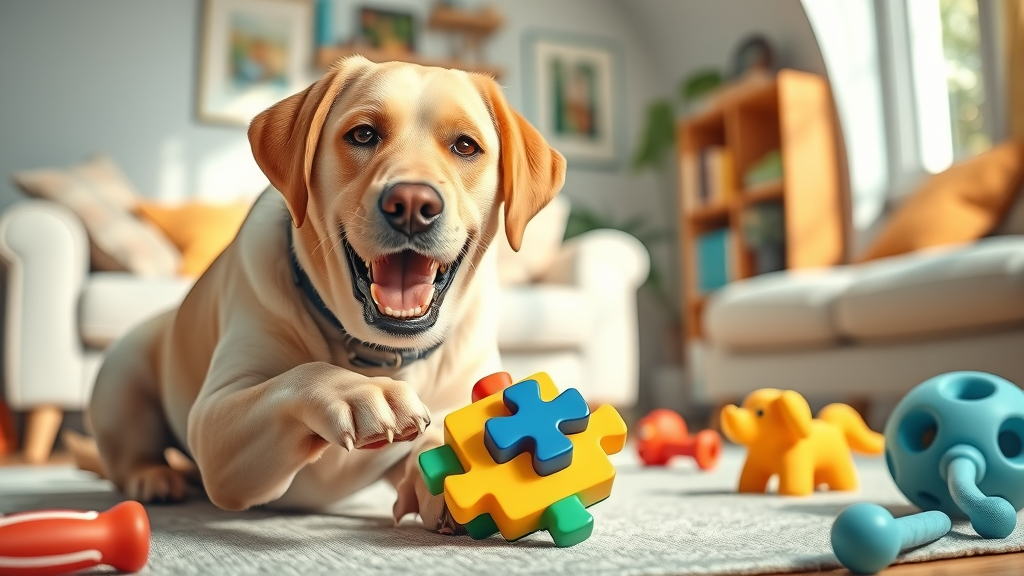
Write A Comment